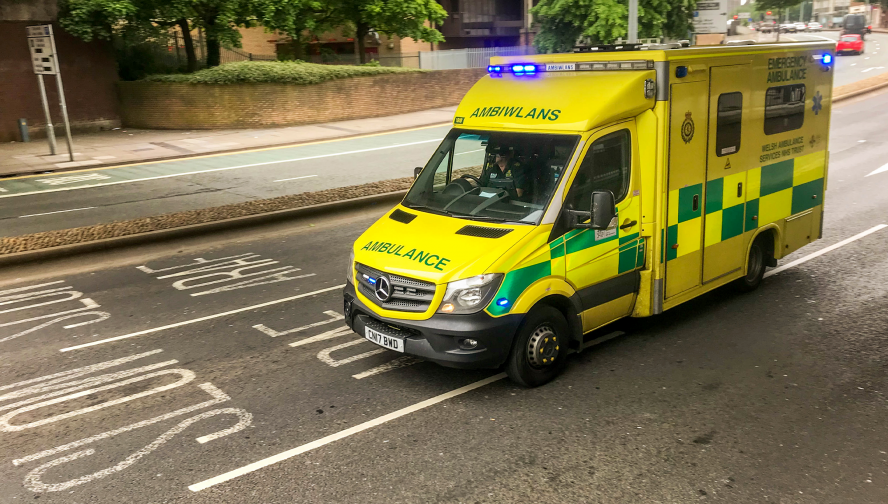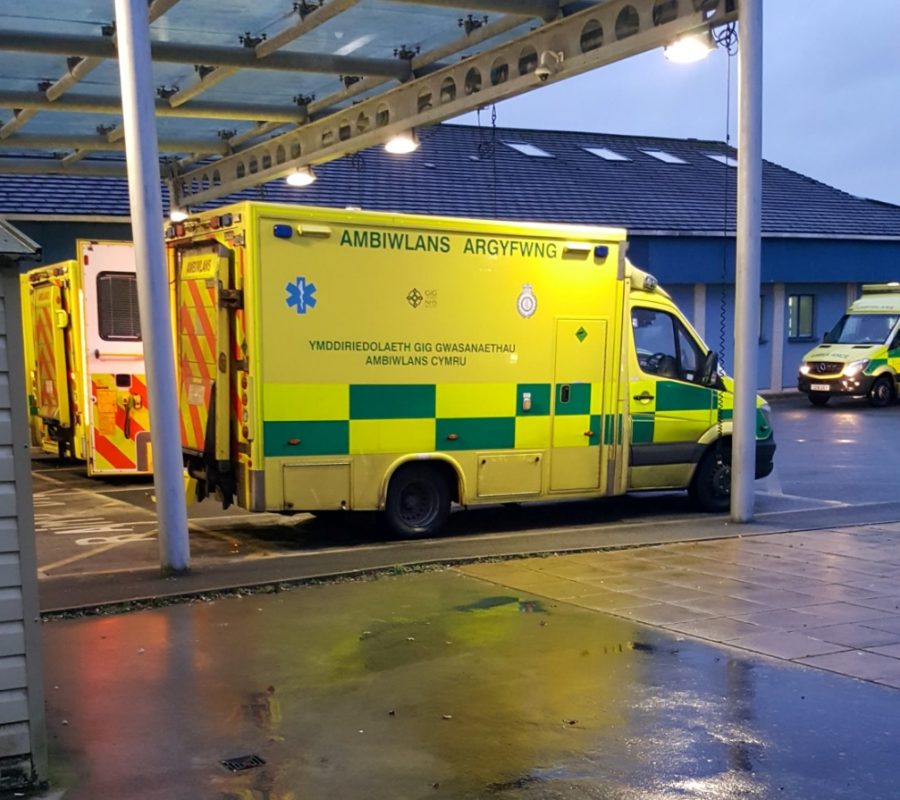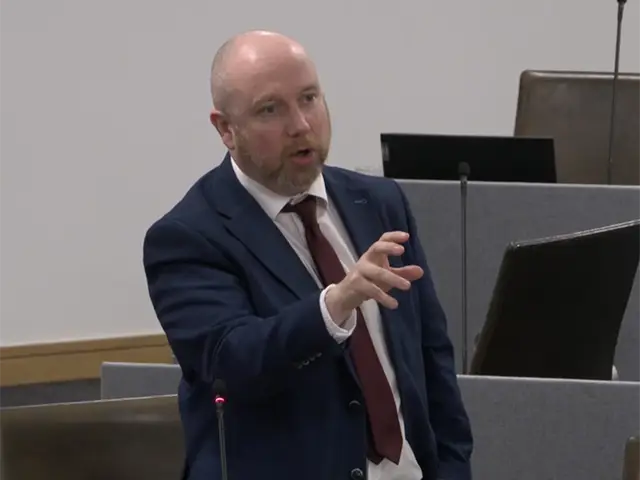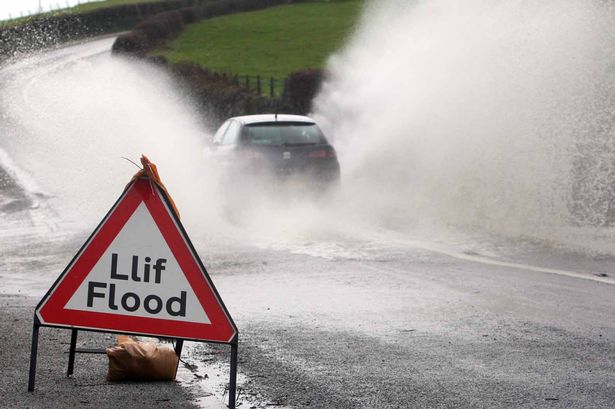Health
Ambulance delays leave Pembrokeshire patients waiting hours

Emergency response times under even more strain
PATIENTS across Wales are facing dangerously long delays as ambulances queue for hours outside A&E departments, with new figures showing an average wait time of nearly two hours for handovers in 2024.
Data obtained by The Herald reveals that more than 23,000 ambulances were stuck outside emergency units for at least four hours last year, while nearly 73,000 endured waits of over an hour—an 18% rise on 2023 and the highest recorded level to date.
The Welsh Ambulance Trust has admitted the situation is unsustainable, blaming it on “sustained and well-documented pressures across the entire NHS in Wales.” The problem is particularly severe in Swansea Bay, where Morriston Hospital reported average handover times exceeding three hours and nine minutes.
Ambulances stuck, patients suffer

When an ambulance arrives at A&E, paramedics are supposed to transfer patients into hospital care within 15 minutes. However, the reality is far different, with official figures showing that in December alone, more than 25,000 hours were ‘lost’ due to excessive waiting times.
The crisis hit a breaking point on 30 December, when the Welsh Ambulance Service declared a critical incident—a rare move—because over half its vehicles were gridlocked outside hospitals, unable to respond to new emergency calls.
“We deeply regret the impact these delays have on our patients and their families,” said Lee Brooks, Executive Director of Operations at the Welsh Ambulance Service. “This is not the standard of service we want to provide.”
Pembrokeshire patients at risk

While much of the focus has been on Swansea and Cardiff, patients in Pembrokeshire are not immune to the chaos. With Withybush Hospital in Haverfordwest already under strain following the downgrading of its A&E services, concerns are growing that West Wales patients are left increasingly vulnerable.
“We see ambulances stacked up outside hospitals, unable to get back on the road,” said a paramedic who wished to remain anonymous. “That means people in Pembrokeshire suffering strokes or heart attacks could be left waiting far too long for help.”
Even ‘red calls’—the most urgent emergencies, including cardiac arrests—are facing challenges. In December, only 47.6% of these life-threatening calls were responded to within the target eight-minute window.

Hospitals struggling to cope
Health officials insist they are working to improve the situation, but a key problem remains the lack of available hospital beds. Many emergency departments simply do not have room to admit new patients, leading to a backlog that begins outside in the ambulance queue.
“In some hospitals, one in five beds is occupied by patients who are medically fit to leave but have nowhere to go due to the lack of social care support,” said Darren Hughes of the Welsh NHS Confederation.
Local NHS managers insist they are trying to speed up discharges to free up hospital space, but the knock-on effect of delays is affecting emergency services across Wales.
What next?
With handover delays now at record levels and no quick fix in sight, health bosses are being urged to rethink how emergency services operate.
“We don’t believe that just adding more ambulances is the answer,” Mr Brooks said. “We need to use the skills of our people differently, ensuring patients get the right care or advice before they even need an ambulance.”
The public is also being urged to think before dialling 999, using services like NHS 111 for less urgent issues to ease the burden on emergency crews.
However, for those in Pembrokeshire who rely on fast emergency response times, the reality remains bleak. As the NHS struggles to cope, the people of West Wales can only hope that help arrives before it’s too late.
Health
Welsh Government intervenes as Gwent health board’s finances ‘deteriorate rapidly’

THE WELSH Government has escalated intervention at Aneurin Bevan University Health Board to one step short of special measures, amid concerns about an £18m deficit and A&E failures.
Jeremy Miles, Wales’ health secretary, announced the Gwent health board will move to level four for finance and emergency care on the government’s five-point scale.
In an update on escalation at each NHS organisation in Wales, Mr Miles warned the health board’s financial position has “deteriorated rapidly” over the past year.
“It is forecasting an £18.3m deficit by the end of March. This is not acceptable,” he said, announcing he will revoke approval of the health board’s three-year plan.
Mr Miles said the health board had been at level three due to concerns about emergency care at the Grange hospital in Cwmbran but will move to level four.
He told the Senedd: “The health board has failed to deliver the required improvements… This will result in direct intervention by the Welsh Government… to improve the timeliness and quality of urgent and emergency care for people living in the Gwent region.”
Mr Miles announced Betsi Cadwaladr Health Board, in north Wales, would remain at level five or special measures. He pointed to interventions including a review of planned care, cancer and emergency services as well as an investigation into management of waiting times data.
But he raised “considerable” progress on governance and leadership at Hywel Dda Health Board following the appointment of a new chair and chief executive.
He announced Hywel Dda will be de-escalated to routine, level-one arrangements for governance and leadership. However, the west-Wales health board remains at level three for planned care and cancer as well as level four for finance and A&E performance.
He told Senedd members he was appointing a “senior turnaround director” to provide support to Cardiff and Vale Health Board, which was placed into level four in July.
Mr Miles said the escalation levels of Cwm Taf Morgannwg, Swansea Bay and Powys health boards, as well as other NHS bodies such as the ambulance services trust, will not change. All seven health boards in Wales remain in some form of escalated status.
In today’s (December 16) statement, Mr Miles said long waits are falling as he pointed to a 43% reduction in lost ambulance hours since the last six-monthly update in July.
But James Evans, the Conservatives’ shadow health secretary, questioned whether intervention is delivering meaningful improvements for patients and staff.

Pointing out that Betsi Cadwaladr Health Board has been “trapped” in special measures for most of the past decade, he told the Senedd: “It is deeply concerning that, once again, we see multiple health boards at levels four and five.”
Mr Evans urged ministers to publish performance metrics, risk assessments and evidence used to assign escalation levels to enable decisions to be properly scrutinised.
He warned focusing on local financial mismanagement of health boards risks ignoring wider, systemic challenges driven by the Welsh Government’s policy and funding decisions.
Plaid Cymru’s Mabon ap Gwynfor agreed with his Tory counterpart about “deeper and more systemic” failures becoming a “constant feature” of the government’s record.

“Measures that should be exceptional, temporary and used only as a last resort have instead become routine,” he said. “It is the people of Wales who are paying the price for that failure.”
The Plaid health spokesperson said Betsi Cadwaladr Health Board has come to “embody the Welsh Government’s failure to embed lasting performance improvement”.
Mr ap Gwynfor told the Senedd: “This situation suggests one of two things: either the special measures system itself is not working or there’s no ceiling to Labour’s mismanagement.”
Mr Miles emphasised that escalation is about supporting health boards, not punishing them. The health secretary also pointed to challenges in other parts of the UK, with 12 of the 14 health boards in Scotland also in escalation.

Speaking ahead of the Senedd debate, South Wales East MS Natasha Asghar said: “This serious intervention is a damning indictment of Labour’s track record when it comes to the health service here in Wales and it is my constituents who are paying the price.
The Conservative MS continued: “Our dedicated NHS staff go above and beyond day in, day out, often under unimaginable pressure, but they are being let down by the chaos and mismanagement from the Labour Welsh Government.
“The problems within our health service have been known for quite some time, yet it appears Labour politicians in the Senedd are either reluctant or totally incapable of doing anything to fix the system.
“The Welsh Government must now finally declare a health emergency and focus all efforts on improving outcomes for patients, driving down shamefully high waiting lists, and turning our health service around.”
Health
Mental Health Foundation: Welsh Government must guarantee prevention funding

Charity sets out manifesto ahead of 2026 Senedd election, warning Wales cannot treat its way out of the mental health crisis
THE MENTAL HEALTH FOUNDATION has published its 2026 Senedd election manifesto, urging all political parties seeking to form the next Welsh Government to move beyond strategy documents and guarantee ring-fenced funding for mental health prevention.
The charity warns that Wales faces a deepening mental health crisis that cannot be solved by treatment and crisis response alone, arguing that sustained investment in prevention is essential if pressure on NHS services is to be reduced and longstanding inequalities addressed.
Strategy welcomed, but funding questioned
The Welsh Government published its Mental Health and Wellbeing Strategy 2025–2035 earlier this year, setting out a ten-year vision for improving mental health outcomes and placing prevention and early intervention at the heart of future policy.
Launching the strategy, Mental Health and Wellbeing Minister Sarah Murphy MS said it marked a shift away from crisis-driven responses, with a stronger focus on tackling the wider causes of poor mental health and improving access to support before people reach breaking point.

However, the Mental Health Foundation says the strategy is not backed by a dedicated or transparent prevention budget, warning that without ring-fenced funding and clear accountability, commitments risk remaining aspirational rather than deliverable.
Mental health decline and rising pressures
Welsh Government wellbeing data shows that overall mental wellbeing has not returned to pre-pandemic levels, with particular concern around children and young people. Evidence also highlights persistent inequalities, with people living in more deprived communities experiencing significantly poorer mental health outcomes.
Public Health Wales has repeatedly raised concerns about rising levels of anxiety, distress and emotional difficulties among young people, alongside clear links to poverty, housing insecurity and wider social pressures.
The Mental Health Foundation argues that these trends underline the need for prevention-focused policies that address the root causes of poor mental health, rather than relying on overstretched clinical services to intervene once people reach crisis point.
‘Words alone won’t change lives’
Alexa Knight, Director of Policy and Influencing at the Mental Health Foundation, said Wales could not “treat its way out” of the crisis.
She said:
“Wales is gripped by a growing mental health crisis, and we cannot treat our way out of it. For too long, policy has focused on treatment and crisis response while neglecting prevention — the very thing that stops problems before they start.
“We welcome the new Mental Health and Wellbeing Strategy and its focus on prevention, but words alone won’t change lives. There is still no dedicated budget for prevention in Wales and no clear way to track spending or impact.
“The next Welsh Government must turn principle into practice with ring-fenced funding and clear accountability.”
Manifesto priorities
The Foundation’s Commitment to Prevention manifesto sets out five priorities for the next Welsh Government:
- prioritising prevention within overall mental health spending
- introducing a Welsh Child Payment to help tackle child poverty
- reaffirming Wales as a Nation of Sanctuary
- developing a dedicated approach to children and young people’s mental health
- addressing the wider social determinants of mental health, including housing, education and employment
The charity says these measures would not only improve wellbeing but reduce long-term costs by easing pressure on health and social care services and improving productivity.
A 2021 economic analysis estimated that poor mental health costs the Welsh economy more than £4.8 billion each year, through healthcare demand, lost productivity and wider social impacts.
Sector support for prevention focus
Health and third-sector organisations across Wales have broadly welcomed the Welsh Government’s emphasis on prevention, while cautioning that delivery will depend on long-term funding, workforce capacity and measurable outcomes.
Mental health charities and NHS bodies have consistently called for stronger coordination across housing, education, employment and community services, arguing that mental health outcomes cannot be improved through healthcare policy alone.
Election issue
With the 2026 Senedd election approaching, the Mental Health Foundation says mental health prevention must be a central political issue, backed by firm financial commitments rather than broad statements of intent.
Without decisive action, the charity warns, Wales risks continuing cycles of crisis care, rising waiting lists and widening inequality — outcomes it says are avoidable with early, sustained investment.
Health
Nurses and doctors warn corridor care ‘normalised’ as pressure mounts on hospitals

NURSES and doctors from Wales’s leading health unions have warned that treating patients in hospital corridors is becoming increasingly routine, as concerns grow over patient safety and overcrowding – including at hospitals serving Pembrokeshire.
Representatives from the Royal College of Nursing (RCN) and the British Medical Association (BMA) gathered at the Senedd on last week (Dec 10) ahead of a debate on so-called ‘corridor care’, where patients are treated in hallways, waiting areas or other unsuitable spaces due to a lack of beds.
The debate was prompted by a joint petition from the two unions calling on the Welsh Government to formally measure the scale of corridor care across Wales and take action to prevent it, including greater investment in community and social care. The petition attracted more than 10,000 signatures from across the country.
In Pembrokeshire, healthcare services are provided by Hywel Dda University Health Board, which runs Withybush Hospital in Haverfordwest alongside hospitals in Carmarthen and Aberystwyth. The health board has repeatedly acknowledged sustained pressure on emergency departments, particularly during winter months, when demand rises and patient flow slows due to difficulties discharging patients into community care.
Union representatives say corridor care is increasingly being reported by frontline staff across Wales, including west Wales, and warn that it poses serious risks to patients.
A recent report by the Royal College of Emergency Medicine estimated there were more than 900 excess deaths in Wales last year associated with long waits in A&E.
Dr Manish Adke, chair of the BMA’s Welsh Consultants Committee, said the practice was deeply distressing for staff.
“As health professionals it is extremely distressing to see patients in unsafe, inappropriate spaces whilst they are at their most vulnerable,” he said.
“What’s worse is that this practice is becoming systematically normalised and that is completely unacceptable. It is not what we trained for, it’s not the care we want to give, and it is putting patients at risk of serious harm.
“Without an allocated bed space we cannot properly stabilise patients with fluids, antibiotics or invasive lines. This leads to poorer outcomes and increases the risk of death.”
Helen Whyley, Executive Director of RCN Wales, said nurses were doing their best in what she described as “dangerous and undignified” conditions.
“Hard-working nurses and healthcare professionals are caring for seriously ill patients in unacceptable conditions, adding stress for staff and patients alike,” she said.
“We are calling on the Welsh Government to work with us and the BMA on solutions, including improved care pathways and greater investment in frontline community services such as district nursing.”
The Welsh Government has previously acknowledged the pressures facing hospitals, particularly in rural areas such as west Wales, where an ageing population and difficulties recruiting staff add to the challenge. Ministers have said delayed hospital discharges – often linked to shortages in social care and community provision – are a major factor in bed shortages.
Hywel Dda University Health Board has also stated in recent updates that it is working to reduce pressure on emergency departments by improving patient flow, expanding same-day emergency care, and working with local authorities to speed up safe discharges.
However, unions argue that without sustained investment outside hospitals, including in social care and community nursing, the problem will persist.
The Welsh Government says it has invested additional funding into health and social care this year and maintains that eliminating corridor care entirely will require system-wide change rather than short-term fixes.
The Senedd debate is expected to hear contributions from across the political spectrum, with patient safety, dignity and winter pressures all likely to feature prominently.
-

 Crime7 days ago
Crime7 days agoKilgetty scaffolder sentenced after driving with cocaine and in system
-

 Crime7 days ago
Crime7 days agoHousing site director sentenced after failing to provide breath sample following crash
-

 News3 days ago
News3 days agoDyfed-Powys Police launch major investigation after triple fatal crash
-

 Crime2 days ago
Crime2 days agoMan sent to Crown Court over historic indecent assault allegations
-

 Crime7 days ago
Crime7 days agoMotorist banned for three years after driving with cannabis in system
-

 Crime4 days ago
Crime4 days agoMan spared jail after baseball bat incident in Milford Haven
-

 Education6 days ago
Education6 days agoTeaching assistant struck off after asking pupil for photos of her body
-

 Crime2 days ago
Crime2 days agoMilford Haven man admits multiple offences after A477 incident
























